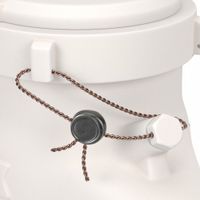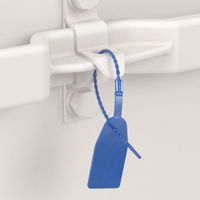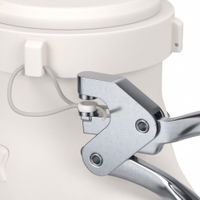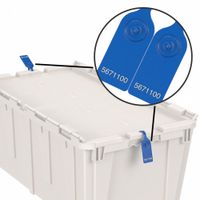Call +(254) 703 030 000 / 751 483 999 / 721 704 777
- Home
- Security
- Security Seals
- Tamper Evident Seals
.....Read More
Frequently Asked Questions
What are tamper-evident seals used for?
Tamper-evident seals are used to provide a clear indication if a product or package has been accessed or altered. They serve as a security measure across various industries to ensure the integrity and authenticity of the contents. These seals are commonly used in the food and beverage industry to prevent contamination and reassure consumers that the product is safe for consumption. In the pharmaceutical sector, they help maintain the safety and efficacy of medications by indicating if a package has been opened or tampered with.
In the electronics and technology industries, tamper-evident seals protect against unauthorized access to devices, ensuring that warranties remain valid and that the product has not been compromised. They are also used in the transportation and logistics sectors to secure shipments, providing a visible deterrent against theft and tampering during transit.
Financial institutions and government agencies utilize tamper-evident seals to safeguard sensitive documents and equipment, ensuring that any unauthorized access is immediately apparent. These seals are designed to leave a visible mark or destroy themselves when tampered with, making it difficult to reseal the package without detection.
Overall, tamper-evident seals are a crucial component of security protocols, providing peace of mind to manufacturers, retailers, and consumers by ensuring that products remain untouched from the point of production to the point of use.
How do tamper-evident seals work?
Tamper-evident seals are security devices designed to indicate whether a product or container has been accessed or altered. They work by providing a clear visual indication of tampering, ensuring the integrity of the contents. These seals are commonly used in various industries, including pharmaceuticals, food, electronics, and transportation.
The basic principle behind tamper-evident seals is that they are designed to be difficult to remove without leaving visible evidence of interference. They often incorporate materials or designs that change appearance or become damaged when tampered with. Here are some common types and mechanisms:
1. **Adhesive Labels**: These seals use strong adhesives that bond to surfaces. When removed, they leave behind a residue or a message, such as "VOID" or "OPENED," indicating tampering.
2. **Breakable Seals**: Made from materials that easily break or tear, these seals cannot be removed without being destroyed. Examples include plastic or metal bands that snap when tampered with.
3. **Shrink Bands**: These are heat-shrinkable bands placed around bottle caps or lids. When heat is applied, they shrink tightly around the closure. Any attempt to remove them results in visible damage.
4. **Security Tapes**: These tapes are designed to leave a residue or pattern on the surface when removed. They often feature holograms or other complex designs that are difficult to replicate.
5. **Electronic Seals**: These use RFID or other electronic technologies to monitor and record access. Any unauthorized access triggers an alert or logs the event.
By providing a clear indication of tampering, these seals help prevent unauthorized access, ensure product authenticity, and maintain consumer trust. They are an essential component of security protocols in supply chains and retail environments.
What types of tamper-evident seals are available?
Tamper-evident seals are designed to indicate unauthorized access to a product or container. Various types are available, each suited to different applications:
1. **Security Labels and Stickers**: These are adhesive labels that leave a residue or a specific pattern (like "VOID") when removed. They are commonly used on packaging, electronics, and documents.
2. **Shrink Bands and Wraps**: Made from plastic, these bands shrink to fit tightly around the neck of a bottle or container when heat is applied. They are often used in the food and beverage industry.
3. **Breakable Seals**: These seals are designed to break or tear when tampered with. Examples include breakable caps on bottles or jars, often used in pharmaceuticals.
4. **Cable Seals**: These are used for securing shipping containers and trucks. They consist of a metal or plastic cable that locks into place and must be cut to be removed.
5. **Bolt Seals**: Commonly used in shipping, these heavy-duty seals require bolt cutters for removal. They are used to secure shipping containers and trucks.
6. **Wire Seals**: These involve a wire threaded through a locking mechanism. They are used in various industries, including utilities and transportation.
7. **Plastic Seals**: These are versatile and used in various applications, from securing bags to sealing containers. They often feature a locking mechanism that must be broken to open.
8. **Electronic Seals**: These advanced seals use electronic components to monitor and record access. They are used in high-security applications.
9. **Tape Seals**: Tamper-evident tape is used on packages and boxes. It leaves a visible mark or message when removed.
10. **Foil Seals**: Often used in the food and pharmaceutical industries, these seals cover the opening of a container and must be peeled off, showing evidence of tampering.
How can I choose the right tamper-evident seal for my needs?
1. **Identify Purpose**: Determine the primary function of the seal—whether it's for security, authentication, or both. Consider if it needs to deter tampering, provide evidence of tampering, or authenticate contents.
2. **Understand Environment**: Assess the conditions the seal will face, such as temperature, humidity, exposure to chemicals, or physical stress. This will influence the material choice.
3. **Material Selection**: Choose from materials like plastic, metal, or paper, based on durability and environmental conditions. Plastic seals are versatile, metal seals offer high security, and paper seals are cost-effective for low-risk applications.
4. **Seal Type**: Decide between fixed-length, adjustable, or barrier seals. Fixed-length seals are tamper-evident and easy to use, adjustable seals offer flexibility, and barrier seals provide high security.
5. **Tamper Evidence**: Look for seals that show clear signs of tampering, such as broken parts, color changes, or visible residue. Consider seals with unique identifiers or serial numbers for added security.
6. **Ease of Use**: Ensure the seal is easy to apply and remove by authorized personnel. Complex seals may deter tampering but can also complicate legitimate access.
7. **Regulatory Compliance**: Verify that the seal meets industry standards and regulations relevant to your sector, such as ISO, C-TPAT, or FDA guidelines.
8. **Cost Consideration**: Balance the cost of the seal with the level of security required. High-security seals may be more expensive but necessary for valuable or sensitive items.
9. **Supplier Reputation**: Choose a reputable supplier with a track record of quality and reliability. Consider their customer support and ability to provide customized solutions.
10. **Testing and Feedback**: Conduct trials to test the seal's effectiveness in real-world conditions. Gather feedback from users to ensure it meets operational needs.
Are tamper-evident seals reusable?
No, tamper-evident seals are not reusable. These seals are specifically designed to provide a clear indication if a package or container has been opened or tampered with. Once a tamper-evident seal is broken or removed, it cannot be reapplied in a way that would maintain its original integrity or appearance. This is because the primary function of these seals is to ensure the security and authenticity of the contents they protect by showing visible signs of tampering.
Tamper-evident seals come in various forms, such as adhesive labels, shrink bands, or security tapes, and they often incorporate features like perforations, special adhesives, or irreversible color changes that activate upon tampering. These features are intentionally designed to make it impossible to remove and reapply the seal without leaving evidence of interference.
The non-reusability of tamper-evident seals is crucial for industries that require high security and trust, such as pharmaceuticals, food and beverage, and electronics. By ensuring that these seals cannot be reused, manufacturers and consumers can have confidence that the product has not been altered or contaminated after it left the production facility.
In summary, the non-reusable nature of tamper-evident seals is a fundamental aspect of their design, serving as a critical security measure to protect the integrity of products and to provide assurance to consumers and businesses alike.
What materials are tamper-evident seals made from?
Tamper-evident seals are made from a variety of materials, each chosen for its specific properties that enhance the seal's effectiveness in indicating unauthorized access. Common materials include:
1. **Plastic Films**: Polypropylene and polyester are frequently used due to their durability and flexibility. These materials can be designed to show visible signs of tampering, such as tearing or stretching.
2. **Metal Foils**: Aluminum foil is often used in tamper-evident seals for its ability to show clear signs of tampering, such as punctures or tears. It is commonly used in pharmaceutical and food packaging.
3. **Paper**: Specially treated paper can be used to create seals that tear easily, making it impossible to remove the seal without leaving evidence of tampering. This is often used in conjunction with adhesives that leave residue.
4. **Void Materials**: These are specialized materials that leave a "VOID" message or pattern on the surface when the seal is removed. They are typically made from a combination of plastic and adhesive layers.
5. **Holographic Films**: These films provide a visual deterrent and are difficult to replicate. They are often used in high-security applications, such as on currency or official documents.
6. **Adhesives**: The adhesive used in tamper-evident seals is crucial. Pressure-sensitive adhesives that leave residue or destroy the seal upon removal are commonly used to ensure that any attempt to tamper is evident.
7. **Security Inks and Coatings**: These can include color-changing inks or coatings that reveal a hidden message or change color when tampered with.
Each material is selected based on the specific application requirements, such as the level of security needed, environmental conditions, and the type of product being protected.
How do I apply and remove tamper-evident seals?
To apply tamper-evident seals, first ensure the surface is clean and dry. Select the appropriate seal type for your application, such as adhesive labels, security tapes, or mechanical seals. Position the seal over the opening or access point, ensuring it covers any potential entry points. Press firmly to ensure full adhesion, especially for adhesive seals, and allow any required curing time. For mechanical seals, ensure they are properly locked or fastened.
To remove tamper-evident seals, carefully inspect the seal for any signs of tampering or damage. For adhesive seals, gently peel back the edge, pulling slowly to avoid leaving residue. Use a solvent or adhesive remover if necessary to clean any remaining adhesive. For mechanical seals, use the appropriate tool or key to unlock or cut the seal, ensuring you do not damage the underlying surface. Always document the removal process for security and compliance purposes.





